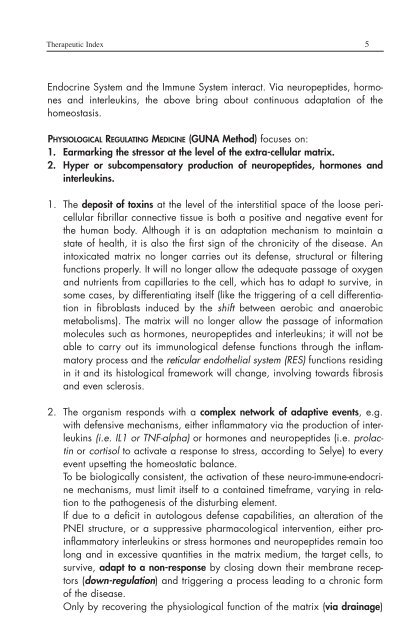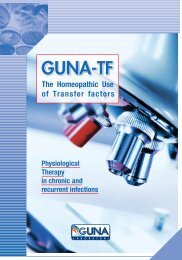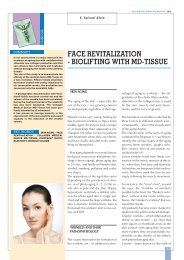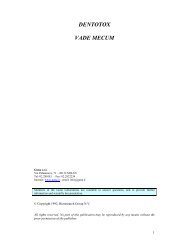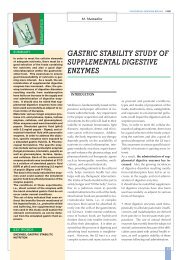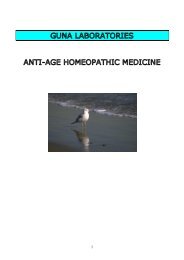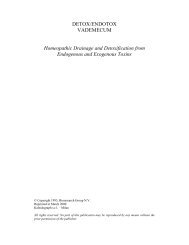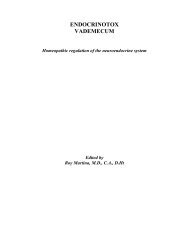Download the Guna Therapeutic Guide - Cyto-Solutions Ltd
Download the Guna Therapeutic Guide - Cyto-Solutions Ltd
Download the Guna Therapeutic Guide - Cyto-Solutions Ltd
You also want an ePaper? Increase the reach of your titles
YUMPU automatically turns print PDFs into web optimized ePapers that Google loves.
<strong>Therapeutic</strong> Index 5<br />
Endocrine System and <strong>the</strong> Immune System interact. Via neuropeptides, hormones<br />
and interleukins, <strong>the</strong> above bring about continuous adaptation of <strong>the</strong><br />
homeostasis.<br />
PHYSIOLOGICAL REGULATING MEDICINE (GUNA Method) focuses on:<br />
1. Earmarking <strong>the</strong> stressor at <strong>the</strong> level of <strong>the</strong> extra-cellular matrix.<br />
2. Hyper or subcompensatory production of neuropeptides, hormones and<br />
interleukins.<br />
1. The deposit of toxins at <strong>the</strong> level of <strong>the</strong> interstitial space of <strong>the</strong> loose pericellular<br />
fibrillar connective tissue is both a positive and negative event for<br />
<strong>the</strong> human body. Although it is an adaptation mechanism to maintain a<br />
state of health, it is also <strong>the</strong> first sign of <strong>the</strong> chronicity of <strong>the</strong> disease. An<br />
intoxicated matrix no longer carries out its defense, structural or filtering<br />
functions properly. It will no longer allow <strong>the</strong> adequate passage of oxygen<br />
and nutrients from capillaries to <strong>the</strong> cell, which has to adapt to survive, in<br />
some cases, by differentiating itself (like <strong>the</strong> triggering of a cell differentiation<br />
in fibroblasts induced by <strong>the</strong> shift between aerobic and anaerobic<br />
metabolisms). The matrix will no longer allow <strong>the</strong> passage of information<br />
molecules such as hormones, neuropeptides and interleukins; it will not be<br />
able to carry out its immunological defense functions through <strong>the</strong> inflammatory<br />
process and <strong>the</strong> reticular endo<strong>the</strong>lial system (RES) functions residing<br />
in it and its histological framework will change, involving towards fibrosis<br />
and even sclerosis.<br />
2. The organism responds with a complex network of adaptive events, e.g.<br />
with defensive mechanisms, ei<strong>the</strong>r inflammatory via <strong>the</strong> production of interleukins<br />
(i.e. IL1 or TNF-alpha) or hormones and neuropeptides (i.e. prolactin<br />
or cortisol to activate a response to stress, according to Selye) to every<br />
event upsetting <strong>the</strong> homeostatic balance.<br />
To be biologically consistent, <strong>the</strong> activation of <strong>the</strong>se neuro-immune-endocrine<br />
mechanisms, must limit itself to a contained timeframe, varying in relation<br />
to <strong>the</strong> pathogenesis of <strong>the</strong> disturbing element.<br />
If due to a deficit in autologous defense capabilities, an alteration of <strong>the</strong><br />
PNEI structure, or a suppressive pharmacological intervention, ei<strong>the</strong>r proinflammatory<br />
interleukins or stress hormones and neuropeptides remain too<br />
long and in excessive quantities in <strong>the</strong> matrix medium, <strong>the</strong> target cells, to<br />
survive, adapt to a non-response by closing down <strong>the</strong>ir membrane receptors<br />
(down-regulation) and triggering a process leading to a chronic form<br />
of <strong>the</strong> disease.<br />
Only by recovering <strong>the</strong> physiological function of <strong>the</strong> matrix (via drainage)


